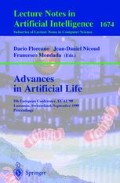Abstract
The paper gives probably the first ever systematic discussion on how wave processes in reaction-diffusion and excitable homogeneous media can be efficiently used to solve a wide range of problems in robot navigation. Three possible applications of chemical controllers are considered: (i) object following, (ii) optimal path finding, and (iii) universal control. The various implementations of controllers discussed here include: Belousov-Zhabotinsky chemical processors, families of excitable lattices, and self-localised excitations. We present some results from a simulation of robot control using excitable lattices, and find the results encouraging for our planned construction of a chemically controlled robot.
Access this chapter
Tax calculation will be finalised at checkout
Purchases are for personal use only
Preview
Unable to display preview. Download preview PDF.
References
Adamatzky A. Universal dynamical computation in multi-dimensional excitable lattices International J. Theor. Physics 37 (1998) 3069–3108.
Adamatzky A. and Holland O. Edges and computation in excitable media In: Proc. ALIFE IV: 6th Int. Conf. on Artificial Life (MIT Press, 1998) 379–383.
Adamatzky A. and Holland O. Phenomenology of excitation in 2D cellular automata and lattice swarm Chaos, Solitons and Fractlas 7 (1998) 1233–1265.
Adamatzky A. and Tolmachev D. Chemical processor for computation of skeleton of planar shape Adv. Mater. Opt. Electron. 7 (1997) 135–139.
Adamatzky A. and Holland O. Parametric classification of local rules of excitation in a lattice: morphology, dynamics and computation Unpublished manuscript, 1998.
Babloyantz A. and Sepulchre J.A. Front propagation into unstable media: a computational tool In: Nonlinear Waves Processes in Excitable Media (A.V. Holden, M. Markus and H.G. Othmer, Eds) (New York and London: Plenum Press, 1991) 343–350.
Braitenber V. Vehicles: Experiments in Synthetic Psychology (The MIT Press: Cambridge, Massachusetts, 1984).
Fredkin E. and Toffoli T. Conservative logic In. J. Theor. Phys. 21 (1982) 219–253.
Hjelmfelt A., Weinberger E.D. and Ross J. Chemical implementation of neural networks and Turing machines Proc. Natl. Acad. Sci. USA 88 (1991) 10983–10987.
Holland O. Grey Walter: The pioneer of real artificial life In: Artificial Life V(The MIT Press, 1997) 34–41.
Jakubowski M., Squier R.K. and Steiglitz K. State transformations of colliding optical solitons and possible application to computation in bulk media Phys. Rev. E 58 (1998) 6752–6758.
Moebius D. and Kuhn H. Energy transfer in monolayers with cyanine dye Scheibe aggregates J. Appl. Phys. 64 (1979) 5138–5141.
Rambidi N.G. An approach to computational complexity: nondiscrete bioiholecular computing Computer 25 (1992) 51–54.
Rambidi N.G. and Yakovenchuk D. Finding path in a labyrinth based on reaction-diffusion media Adv. Mat. Optics and Electronics (1998) (in print).
Rambidi N.G. and D.S. Chernavskii Toward a biomolecular computer. 1. Ways, means, objectives J. Mol. Electron. 7 (1991) 105–114.
Rambidi N.G., Maximychev A.V. and Usatov A.V. Molecular image processing based on chemical reaction systems. 1. Implementation of Blum-type algorithm Adv. Materials Optics Electr. 4 (1994) 191–201.
Steiglitz K., Kamal I. and Watson A. Embedded computation in one-dimensional automata by phase coding solitons IEEE Trans. Comp. 37 (1988) 138–145.
Steinbock O., Kettunen O. and Showalter K.J. Anisotropy and spiral organizing centers in patterned excitable media Science 269 (1995) 1857–1860.
Steinbock O., A. Toth and K. Showalter Navigating complex labyrinths: optimal paths from chemical waves Science 267 (1995) 868–871.
Tolmachev D. and Adamatzky A. Chemical processor for computation of Voronoi diagram Adv. Mater. Opt. Electron. 6 (1996) 191–196.
Toth A. and Showalter K. Logic gates in excitable media J Chem Phys 103 (1995) 2058–2066.
Tu Y. Worm structure in modified swift-hohenberg equation for electroconvection patt-sol/9701001.
Walter G. W. An imitation of life Scientific American (1950) 42–45.
Zigler J., Dittrich P. and Banzhaf W. Towards a metabolic robot control system In: Proc. 2nd Int. Workshop Information Processing in Cells and Tissues (New York: Plenum Press, 1997) 305–318.
Author information
Authors and Affiliations
Editor information
Editors and Affiliations
Rights and permissions
Copyright information
© 1999 Springer-Verlag Berlin Heidelberg
About this paper
Cite this paper
Adamatzky, A., Holland, O., Rambidi, N., Winfield, A. (1999). Wet Artificial Brains: Towards the Chemical Control of Robot Motion by Reaction-Diffusion and Excitable Media. In: Floreano, D., Nicoud, JD., Mondada, F. (eds) Advances in Artificial Life. ECAL 1999. Lecture Notes in Computer Science(), vol 1674. Springer, Berlin, Heidelberg. https://doi.org/10.1007/3-540-48304-7_39
Download citation
DOI: https://doi.org/10.1007/3-540-48304-7_39
Publisher Name: Springer, Berlin, Heidelberg
Print ISBN: 978-3-540-66452-9
Online ISBN: 978-3-540-48304-5
eBook Packages: Springer Book Archive

